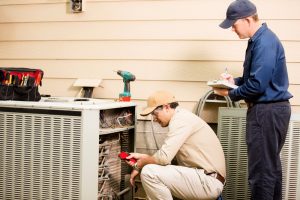 Spring has barely just begun, but before you know it, summer will be right around the corner.
Spring has barely just begun, but before you know it, summer will be right around the corner.
Before that time comes, we urge you to check in on your air conditioner and to see if everything is still working alright. Half a year without activity can cause an AC to develop some issues that you won’t want to worsen by forcing it to operate. For that, you can get a quick tune-up from an AC expert.
While you’re inspecting your AC, you’ll also want to consider if this year is finally the year that you’ll replace your air conditioner. After all, that maintenance check won’t do much good if your AC is already in the decline.
We’ll give you the complete rundown on AC replacement, including when it’s needed, how to find a better system, and what to expect from installation.
1. Determine If Your AC Needs Replacement
With all this talk of replacement, we first want you to ensure that your AC even needs it in the first place. If your AC is experiencing more than one of these signs, then it’s enough to consider discussing options with your preferred air conditioning contractor in Portland, OR.
- The unit is over ten years old.
- Your cooling bills are getting higher and higher.
- The need for repairs has been occurring more frequently.
- It’s simply not cooling like it used to.
2. Consider Features and Systems
If your AC is indeed up for replacement, you’ll want to consider what kind of AC you want.
Many homeowners tend to opt for whatever system they’ve already been using. After all, why change what’s already working? However, other systems offer a range of benefits that might suit your needs better. Some things to consider include:
- Do you want to keep using your duct system?
- Do you want to consolidate heating and cooling into one system, or are you fine with them being separate?
- Will you be moving out of this home soon? You might not want to install something too expensive.
3. SEER Ratings
After finding your ideal system, it then comes down to quality of the system. When we talk about quality, one part of that conversation is about brands, manufacturers, and warranties. The other half of that conversation, however, is about the Seasonal Energy Efficiency Ratio (SEER) rating.
Essentially, a higher SEER rating means a more efficient system, which means you’ll be paying a lower monthly cooling bill. Investing in an expensive system upfront might save you hundreds of dollars in the long run.
4. Sizing and Installation
The last steps are sizing the air conditioner for your home and finally installing it.
When we say “sizing,” we don’t mean fitting it into your home physically. Rather, we’re referring to its output capabilities. The AC’s output must match your home so that it is neither too powerful nor too weak. An improperly sized AC will only bring efficiency issues and might even require replacing the system again.
5. Enjoy!
These steps made it seem easy, but that’s only because we’re speaking as professionals. Contact a professional in air conditioning services to ensure that your AC replacement goes just as smoothly.
Contact The Clean Air Act to schedule a free estimate for AC replacement or installation.
